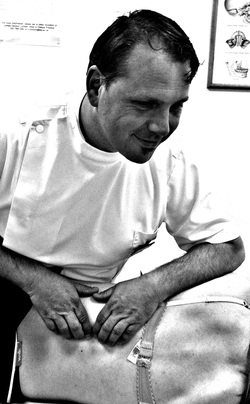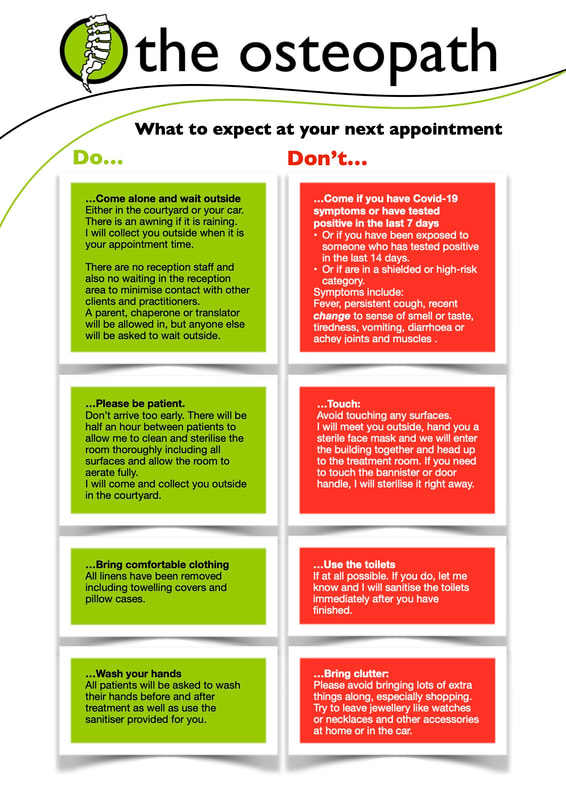Osteopathy in Crystal Palace and Harley Street
What to expect at the osteopath
Your medical history

As osteopaths, we are Allied Health Professionals registered as Primary Healthcare Practitioners so before I start to treat you, I will make a full medical assessment. I take time to listen to you and ask questions to make sure I understand your medical history and your day-to-day routine. I will ask you about things like what you like to eat, exercise and what is happening in your life, as these may give clues to help my diagnosis.
I may feel your pulse and check your reflexes. I may also take your blood pressure and refer you for clinical tests, such as an MRI or back to your GP or another specialist, if I think it clinically necessary.
Your posture
I will usually look at your posture and how you move your body. I will also assess what happens when I move it for you and see what hurts, where and when.
As with any medical examination, to facilitate a full examination of the spine or problem area you will probably be asked to undress to your underwear, so please wear something you are comfortable in. If you feel more comfortable in a T-shirt and shorts, there are changing facilities available.
Trouble areas
Using touch, I may also find the areas which are sensitive or tight and this helps me to identify what’s going on.
When I have done this, I can diagnose your condition. If I feel that osteopathy is not appropriate for you I may refer you to your GP or another specialist such as a podiatrist.
Your treatment
Osteopaths use a wide range of gentle techniques, depending on your age, fitness and diagnosis.
Treatment is different for every patient but may include techniques such as different types of soft tissue massage and joint articulation to release tension, stretch muscles, help relieve pain and mobilise your joints.
Sometimes, when we move joints you may hear a ‘click’. This is just like the click people get when they crack their knuckles. But 'clicking' or 'cracking' a joint (as some people call it - we prefer the term 'mobilising' or HVT - High velocity, low amplitude thrust) is not essential to treatment and sometimes not appropriate for every patient. If you don't like having it done, just say so and we can try a different way to get you moving better.
I may discuss with you exercises that you can do to improve your posture and movement in your workplace and everyday life.
Consent
No healthcare practitioner should proceed without informed consent, so I will always ask for consent before any treatment commences. If you would like something explained more clearly, just ask and I will be more than happy to do so. I don't believe osteopathic treatment should be painful or make you feel uncomfortable, so if at any point during the examination or treatment you are feeling uncomfortable or would like to stop for any reason, just let me know and I will stop.
During the Covid-19 pandemic, what has changed and what can you expect?
Click here for our Covid-19 and Infection Control Policy
I may feel your pulse and check your reflexes. I may also take your blood pressure and refer you for clinical tests, such as an MRI or back to your GP or another specialist, if I think it clinically necessary.
Your posture
I will usually look at your posture and how you move your body. I will also assess what happens when I move it for you and see what hurts, where and when.
As with any medical examination, to facilitate a full examination of the spine or problem area you will probably be asked to undress to your underwear, so please wear something you are comfortable in. If you feel more comfortable in a T-shirt and shorts, there are changing facilities available.
Trouble areas
Using touch, I may also find the areas which are sensitive or tight and this helps me to identify what’s going on.
When I have done this, I can diagnose your condition. If I feel that osteopathy is not appropriate for you I may refer you to your GP or another specialist such as a podiatrist.
Your treatment
Osteopaths use a wide range of gentle techniques, depending on your age, fitness and diagnosis.
Treatment is different for every patient but may include techniques such as different types of soft tissue massage and joint articulation to release tension, stretch muscles, help relieve pain and mobilise your joints.
Sometimes, when we move joints you may hear a ‘click’. This is just like the click people get when they crack their knuckles. But 'clicking' or 'cracking' a joint (as some people call it - we prefer the term 'mobilising' or HVT - High velocity, low amplitude thrust) is not essential to treatment and sometimes not appropriate for every patient. If you don't like having it done, just say so and we can try a different way to get you moving better.
I may discuss with you exercises that you can do to improve your posture and movement in your workplace and everyday life.
Consent
No healthcare practitioner should proceed without informed consent, so I will always ask for consent before any treatment commences. If you would like something explained more clearly, just ask and I will be more than happy to do so. I don't believe osteopathic treatment should be painful or make you feel uncomfortable, so if at any point during the examination or treatment you are feeling uncomfortable or would like to stop for any reason, just let me know and I will stop.
During the Covid-19 pandemic, what has changed and what can you expect?
Click here for our Covid-19 and Infection Control Policy

